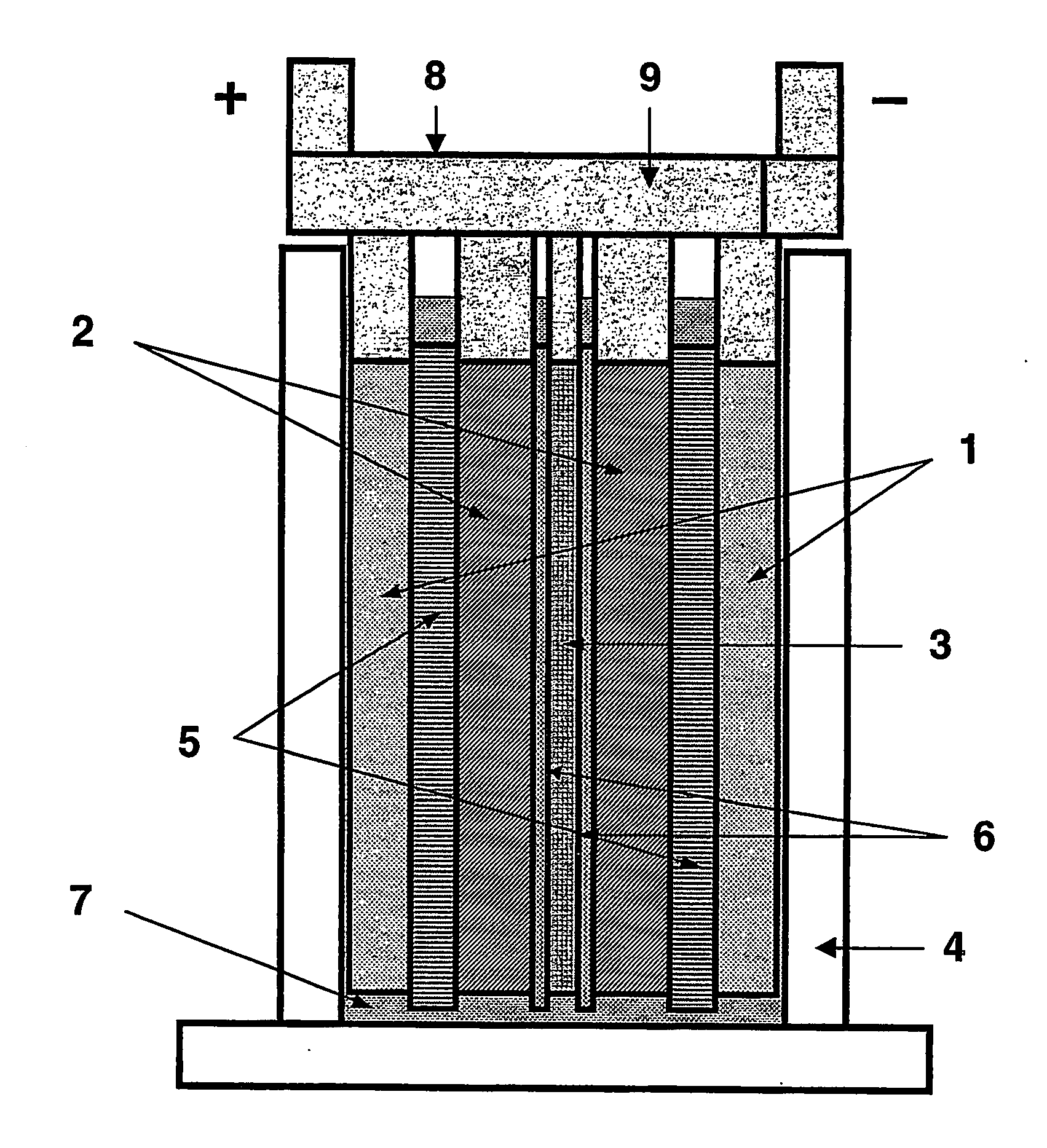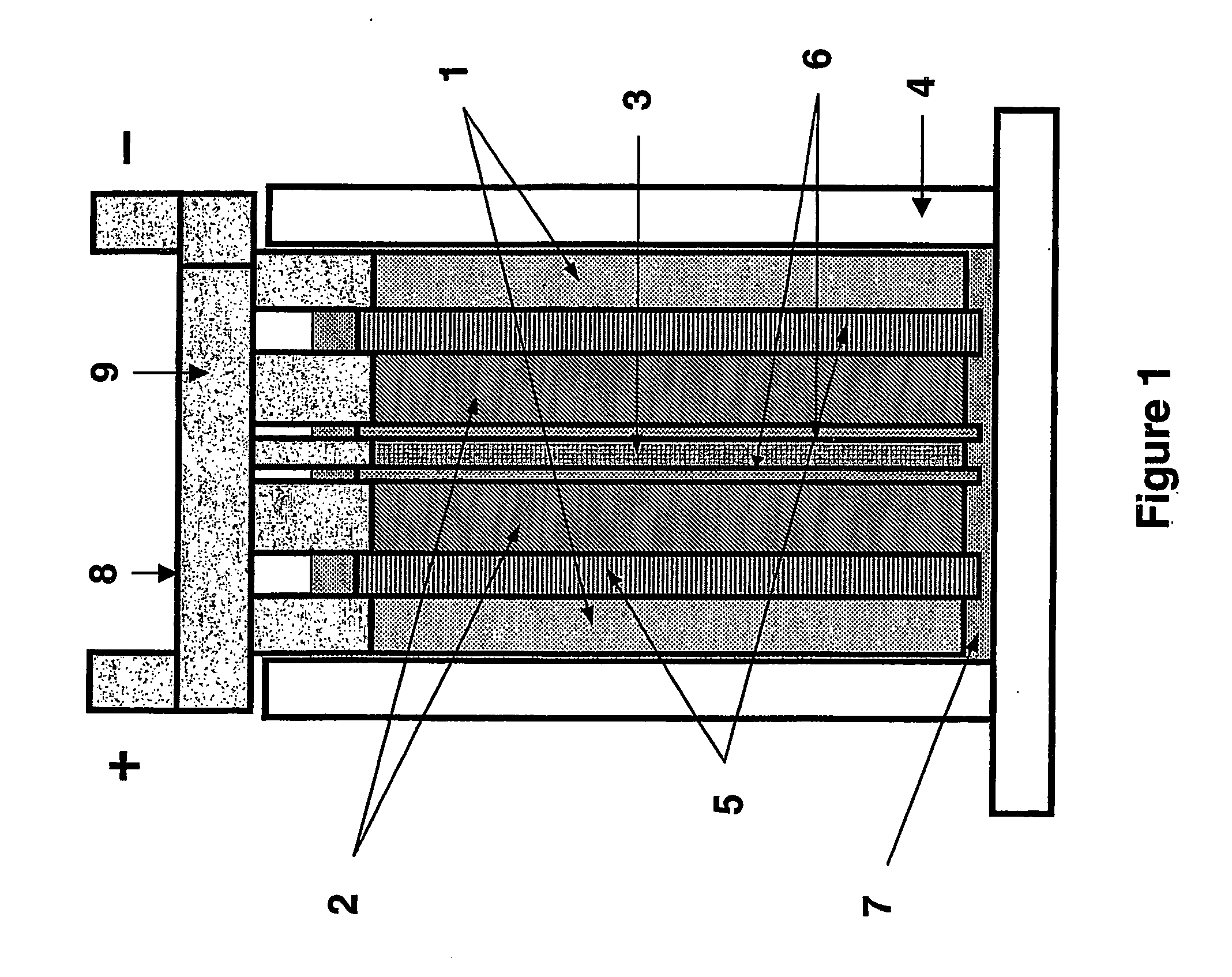High performance energy storage devices
a technology of energy storage and high-performance batteries, which is applied in the direction of battery, sustainable manufacturing/processing, cell components, etc., can solve the problems of lead-acid batteries failing prematurely, sulphate cannot be efficiently converted back to sponge, and the batteries used in these vehicles still suffer from a number of problems
- Summary
- Abstract
- Description
- Claims
- Application Information
AI Technical Summary
Benefits of technology
Problems solved by technology
Method used
Image
Examples
example 1
[0106] A lead-acid battery of one embodiment of the invention suitable for testing purposes was made in the arrangement as illustrated schematically in FIGS. 1 and 2.
[0107] Two sponge lead (negative plate) electrodes (1), two lead dioxide positive plate electrodes (2) and one high surface-area negative carbon electrode plate (3) were positioned in an alternating arrangement as illustrated in FIG. 1 in a battery case (4). The positive lead dioxide electrodes (2) and negative lead electrodes (1) were 40 millimetres wide by 68 millimetres high by 3.3 millimetres thick. The carbon electrode (3) was 40 millimetres wide by 68 millimetres high by 1.4 millimetres thick. The battery electrodes were of a standard configuration and composition for lead-acid batteries, and were made by the methods described in the detailed description above. The lead electrode formation techniques used in this example are more fully described in our copending application PCT / AU2003 / 001404, the entire contents ...
example 2
[0127] A variation on the battery of Example 1 is illustrated in FIGS. 5 and 6. For ease of comparison, the same numerals are used to refer to common features of the two batteries.
[0128] The embodiment of this Example comprises three lead dioxide positive plate electrodes (2) and two composite negative electrodes (16). The composite negative electrodes comprise a current collector or grid (17) with the lead-containing paste composition described above applied to one region (the face) thereof (18) and capacitor high surface-area carbon electrode material-containing paste applied to the opposite face (19). Formation of the electrode is conducted in the manner known in the art. In a variation on this embodiment that is simpler to manufacture, a lead based negative electrode is prepared with lead pasted by conventional dipping techniques to the main body section in lead paste material, followed by formation, and then the capacitor material is pasted to a region or regions of this lead ...
example 3
[0132] Further testing on the battery of Example 1 showed that improvements in electrolyte dry-out could be achieved by matching the hydrogen evolution rate of the carbon electrode (3) during battery charging to be similar to that of the lead negative electrode (1). This was achieved by replacing the carbon electrode of Example 1 with a modified carbon electrode (103) with 2.5 wt % PbO and 2.5 wt % ZnO, 65 wt % activated carbon, 20 wt % carbon black and binder (10 wt %) in the paste composition.
[0133] The hydrogen evolution rates for this electrode were tested and compared to the electrode used in Example 1, as well as the hydrogen evolution rates of the lead negative electrode of example 1. The results are shown in FIG. 7, in which curve 20 represents the carbon electrode hydrogen evolution rate, curve 21 represents the lead-acid negative plate hydrogen evolution rate, and the curve 22 represents the carbon plus additives electrode hydrogen evolution rate. The higher current densi...
PUM
| Property | Measurement | Unit |
|---|---|---|
| thickness | aaaaa | aaaaa |
| thickness | aaaaa | aaaaa |
| voltage window | aaaaa | aaaaa |
Abstract
Description
Claims
Application Information
 Login to View More
Login to View More - R&D
- Intellectual Property
- Life Sciences
- Materials
- Tech Scout
- Unparalleled Data Quality
- Higher Quality Content
- 60% Fewer Hallucinations
Browse by: Latest US Patents, China's latest patents, Technical Efficacy Thesaurus, Application Domain, Technology Topic, Popular Technical Reports.
© 2025 PatSnap. All rights reserved.Legal|Privacy policy|Modern Slavery Act Transparency Statement|Sitemap|About US| Contact US: help@patsnap.com



